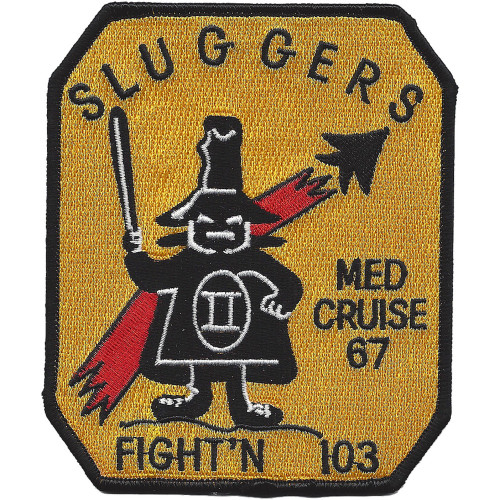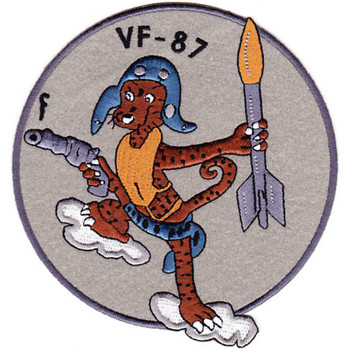Formations & Origins
Fighter Squadron 103 (VF-103), originally known as the "Sluggers," was established in May 1952. By 1967, during the height of Cold War tensions and U.S. military expansion, VF-103 had evolved into a critical part of the Navy’s carrier air wing structure. That year, the squadron deployed aboard the USS Saratoga (CVA-60) for a Mediterranean cruise. The “Med Cruise ‘67” patch commemorates that deployment, a peacetime yet high-stakes tour in which U.S. naval aviation was flexing its presence across NATO waters and ensuring stability amid Cold War standoffs and regional flare-ups.
Notable Commanders
While individual names from the 1967 cruise aren't widely recorded, VF-103 during this period was typically led by battle-hardened aviators with experience in Korea or early Vietnam. These were no-nonsense leaders who expected excellence on the flight deck and in the air. Their job was to keep the squadron razor sharp in an era where the margin between routine and combat could shrink to seconds — especially in a theater as volatile as the Mediterranean, where Soviet and U.S. forces often flew within visual range.
Major Campaigns/Operations
The 1967 Mediterranean cruise wasn't a combat tour per se, but that doesn’t mean it was quiet. VF-103's mission was strategic presence and readiness. Flying from the decks of the Saratoga, they conducted air patrols, training exercises, and carrier-based readiness operations across the Sixth Fleet’s area of responsibility. This was the same year the Six-Day War broke out between Israel and its neighbors, and tensions ran high. American carrier groups in the Med, including those with VF-103 onboard, had to remain on full alert. Phantom IIs were launched on short notice, operating near potential flashpoints, ensuring the Navy had eyes in the sky and steel in reserve.
Specialized Role/Equipment
In 1967, VF-103 was flying the F-4B Phantom II — one of the most iconic fighters of its generation. The Phantom was a twin-engine, long-range interceptor and fighter-bomber capable of carrying Sparrow and Sidewinder missiles as well as bombs for air-to-ground roles. It had no internal gun, a decision rooted in the Navy’s belief in missile-dominant dogfighting — a choice that would later be debated. VF-103’s Phantoms patrolled the skies with one goal: own them. Whether it was intercepting Soviet Tu-95 "Bear" bombers shadowing the fleet or training against fellow American squadrons, VF-103’s job was to dominate any aerial opponent and protect the battle group.
Acts of Heroism
Though the 1967 cruise was not a direct combat deployment, the margin for catastrophe aboard carriers and in the skies was razor thin. VF-103 crews flew night ops, simulated combat intercepts, and cross-deck missions, often under brutal conditions. One story passed down anecdotally tells of a VF-103 crewman who managed to safely bring back a damaged Phantom II after a near-catastrophic in-flight systems failure over the Ionian Sea. Fighting both mechanical chaos and fading light, the pilot executed a textbook carrier landing with only one functioning engine and partial hydraulics — the kind of thing that doesn’t make the news, but earns eternal respect in the ready room.
Legacy & Notable Achievements
The VF-103 “Med Cruise ’67” patch is a tribute to a different kind of mission — the peacetime deterrent, the ever-present force on the horizon, the steel glove in the velvet sheath. Though it lacked the gunfire of Southeast Asia, the tour was emblematic of how naval aviation shaped geopolitical stability during the Cold War.
In 1995, VF-103 took on a new identity, adopting the legendary skull-and-crossbones insignia of the disestablished VF-84 and becoming the “Jolly Rogers” — a name now synonymous with naval aviation history. But the roots of their prowess, discipline, and esprit de corps trace back to deployments like the 1967 Med Cruise. That patch — often depicting a grinning Phantom or crossed sabers over the Med — is worn by veterans and collectors alike with pride, symbolizing not just where they went, but who they were: Sluggers on deck, masters of the sky.







